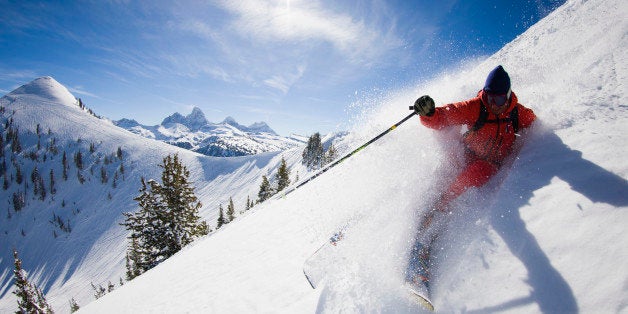
I've always been somewhat of a late bloomer. It wreaked havoc on my professional football career: I was 5'3' and 98 pounds as a freshman in high school. Nevertheless, I didn't let that get me down. It took a little longer, but I still managed to play into my college years. The same goes for rock climbing. I didn't start that until I was 28, and now I have a sponsor. Snowboarding? I started snowboarding two months before my 30th birthday.
If you're like me and want to learn to ski or snowboard in your 30s or beyond, here are the top things you need to know:
1. We don't learn as fast as we used to.
You know the saying, "you can't teach an old dog new tricks?" Yup, that's a real thing. Gone are the days when our brains are like a sponge. Luckily, it's not entirely all our fault. In this story from ABC News, researchers believe it's due to changes in the hippocampus of our brain and the reduction of synapses. Before we hit puberty, we have plenty of excess receptors just waiting to latch on to any new information (in the form of neurotransmitters).
As we age and stop challenging ourselves to learn new things and make new memories, we lose our neuroplasticity. That is, our brain starts shedding "useless things we don't need to know" (memories) in the form of synapses. Unfortunately, synapses are also linked to learning and a host of other brain functions too. So, if you don't use it, you lose it.
2. We're not so coordinated anymore.
In a gross oversimplification, coordination and balance are made up of three complex systems in the body: proprioception, vestibular, and vision. Proprioception is the brain's ability to determine where all of your joints are located in space and know exactly what they're all doing at all times. The vestibular system takes place in your inner-ear. It's what tells your brain if you're right-side up or upside down if you happen to be blindfolded. Which leads to vision. Vision uses external reference points to give us spatial awareness and tells us to watch out for that upcoming tree.
Just think of all the joints in your body, constantly moving, with an ever changing scenery, over tumultuous terrain, and at speed. It's easy to see how sitting in an office chair for the previous five years has not prepared you for what you're about to do.
3. It hurts when we fall.
First re-read points one and two. Now accept that you're going to fall. And when you fall, it's going to hurt more than your younger years. This happens for a couple of reasons. The first reason is simply that we know it's going to hurt, as opposed to the bliss of ignorance when we're young. This causes us to tense all the muscles in our body and become very rigid prior to impact. When we're rigid, we don't bend; we break.
Very similarly is reason two: we are likely not as active as we were when we were 19. We don't constantly move all of our joints and all of our muscles in all of the planes of motions they're intended to move (elasticity). More plausible is that we sit at a desk for 8 hours/day, 5 days/week. We don't move like we used to move, and believe it or not, our body adapts just the same. If it doesn't have to move, it won't. If it doesn't have to flex, it won't. We go from being elastic little gumbies, bouncing off the walls, to less than stoic statues sitting at our desks all day.
Think
Lucky for us, there's good news in becoming older and wiser. Although we can't learn something new on the very first try anymore, we do have critical thinking skills that might have been lacking as a know-it-all teenager.
We're also a little more patient. If the instructor doesn't (and won't) tell you how to handle every conceivable situation you encounter on the hill, we can stop, take our time, think it through, and make the best decision possible. This will greatly reduce the amount of out-of-control falls you take...and pain you'd be in.
Find other ways to learn
Try learn in different ways. I needed to repeat the steps the instructor gave me out loud as I was snowboarding. I finally started linking my S-turns together by saying aloud, "left toes, right toes; left heel, right heel..." Even with a full season under my belt, I still found myself saying the same thing when learning to ride switch.
Ignore everyone else
I didn't want to say this before, but we don't look very cool either. Not only is our sense of ski fashion more functional than fashionable, but we look really awkward in our movements too. (See point number 2 above.) Thankfully we don't have the same social pressure as teens to "fit in."
Honestly, no one cares what you look like. And even if they do, oh well! You'll never see them again. Just ignore everyone else and focus on what you're doing. Have fun!
But you know, even if you do happen to make a bad move once or twice, at least now you can use your real-life, adult wallet to go have a cocktail in the chalet or pay for a doctor visit.
